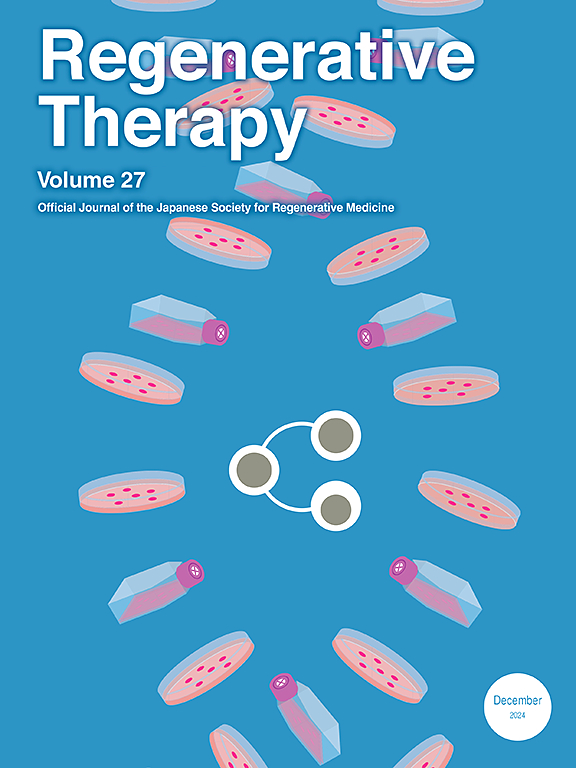From an Antimicrobial Agent to a constituent of 3D Printed Heterogenous Scaffolds Stimulating Bone Characteristics: An In-vitro and Animal model evaluation
IF 3.5
3区 环境科学与生态学
Q3 CELL & TISSUE ENGINEERING
引用次数: 0
Abstract
This paper describes a promising candidate molecule, investigates the pattern of scaffold composition which arises and assesses the effect of the agent on its mechanical properties.
Methods
Scaffold samples were fabricated using a commercial extrusion bioprinter equipped with a pneumatic printhead fitted with a 21G conical nozzle. The Pore Printability Index, and the area and perimeter of the pore within the grid patterns were quantified using ImageJ software (NIH, USA). Mechanical properties of scaffolds were assessed using atomic force microscopy. The phase composition and crystal structures were analyzed using X-ray diffraction and Raman mapping. Morphologies of human gingival fibroblastic cells were examined using scanning electron microscopy. Lactobacillus biofilms were generated for cytolysin peptide cleavage. A rabbit bone defect model with scaffold implantations was used to provide histologic specimens for measuring percentages of bone trabeculae, collagen fibers and inflammatory cells along with granulation tissue. The Primeway Total RNA Extraction Kit was used for RNA extraction.
Results
All bioink formulations demonstrated successful printing of 3D grid and solid square patterned scaffolds achieving Pr values exceeding 0.9. 0.1 %K21 group showed the highest elastic modulus. XRD revealed a pattern producing around 90 % β-tricalcium phosphate displaying two peaks at 2θ angles. 0.1 % K21 and 0.1 %CHX did not alter scaffold's pore size and porosity. 0.1 %K21 group exhibited highest ratio (62.5 ± 6.1 θ), significantly surpassing control. Surface morphologies of cells were also well retained. TEM image shows a sequence of structural changes in fibroblastic cell structure when exposed to K21. 0.1 % K21 proved to be critical in completely eradicating the biofilm. 0.K21 group closed the openings of wound areas completely. Correlation coefficient of gene expression levels demonstrates sample variations and recurring instances among groupings.
Conclusion
3D-printing technologies with 0.1 %K21 represent a significant advancement over conventional regenerative medicine techniques for bone-related treatments.
从抗菌剂到3D打印异质支架刺激骨特性的成分:体外和动物模型评估
本文描述了一个有前途的候选分子,研究了支架组成的模式,并评估了该剂对其力学性能的影响。方法采用商用挤压生物打印机制备支架样品,该打印机配备21G锥形喷嘴的气动打印头。使用ImageJ软件(NIH, USA)对孔隙可打印性指数以及网格模式内孔隙的面积和周长进行量化。采用原子力显微镜观察支架的力学性能。利用x射线衍射和拉曼图分析了相组成和晶体结构。用扫描电镜观察了人牙龈成纤维细胞的形态。制备乳酸菌生物膜裂解细胞溶素肽。采用支架植入兔骨缺损模型提供组织学标本,测定骨小梁、胶原纤维、炎性细胞及肉芽组织的百分比。采用Primeway总RNA提取试剂盒进行RNA提取。结果所有生物墨水配方均成功打印出三维网格和实心方形支架,Pr值均超过0.9。0.1% K21组弹性模量最高。XRD谱图显示,β-磷酸三钙含量约为90%,在2θ角处有两个峰。0.1%的K21和0.1%的CHX没有改变支架的孔径和孔隙率。0.1% K21组比例最高(62.5±6.1 θ),显著高于对照组。细胞的表面形态也保留得很好。TEM图像显示了暴露于K21时成纤维细胞结构的一系列结构变化。0.1%的K21被证明是完全根除生物膜的关键。0.K21组完全闭合创面开口。基因表达水平的相关系数显示了样本差异和组间反复出现的情况。结论添加0.1% K21的3d打印技术在骨相关治疗方面是传统再生医学技术的重大进步。
本文章由计算机程序翻译,如有差异,请以英文原文为准。
求助全文
约1分钟内获得全文
求助全文
来源期刊

Regenerative Therapy
Engineering-Biomedical Engineering
CiteScore
6.00
自引率
2.30%
发文量
106
审稿时长
49 days
期刊介绍:
Regenerative Therapy is the official peer-reviewed online journal of the Japanese Society for Regenerative Medicine.
Regenerative Therapy is a multidisciplinary journal that publishes original articles and reviews of basic research, clinical translation, industrial development, and regulatory issues focusing on stem cell biology, tissue engineering, and regenerative medicine.
 求助内容:
求助内容: 应助结果提醒方式:
应助结果提醒方式:


